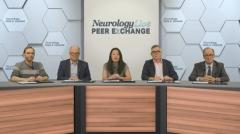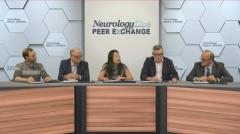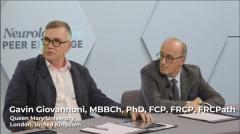
BTKi Mechanism of Action
Neurology experts discuss the mechanism of action of BTKi’s for the treatment of multiple sclerosis.
Episodes in this series

Gavin Giovannoni, MBBCh, PhD, FCP, FRCP, FRCPath: I know the class of Bruton tyrosine kinase inhibitors targets one or two components of the smoldering multiple sclerosis hypothesis, but the fundamental question is, do we set up the environment for smoldering MS via focal inflammation or are they independent of each other? I'm not sure this class of therapy will allow us to answer that question. Do you think we can dissect that out using BTK inhibitors?
Amit: I don't think so, not easily. I mean, one of the areas we don't know much about still relates to trafficking into the central nervous system. Historically we considered the CNS immune privileged; we now appreciate it is not. It plays by different rules than the periphery, but there's constant immune cell percolation through the CNS and out as part of immune surveillance. We know that because if we stop trafficking, people can get progressive multifocal leukoencephalopathy. What we don't fully understand is the exact routes of immune cell ingress and egress—it's probably not the same perivascular postcapillary venules involved in the pathology of focal inflammatory multiple sclerosis lesions.
Is the problem, at some level, trafficking of cells that don't leave as quickly as they should and then start an autoimmune attack on the CNS? When it starts and how it starts is unclear, so dissecting and interrupting that cycle is challenging.
Gavin Giovannoni, MBBCh, PhD, FCP, FRCP, FRCPath: I suppose the phase 3 program results with MRI and biomarkers will provide insights about the intrathecal central nervous system B-cell compartment, the microglial compartment. But I think peripheral inflammation must drive the microglial activation because of the positron emission tomography imaging data with natalizumab from Finland about a year ago. People on natalizumab, which we don't think crosses the blood-brain barrier significantly, had reduced translocator protein signal. So obviously peripheral inflammation drives—beyond the focal inflammatory translocator protein signal, that's key. So I suppose there must be some relationship between focal inflammation and smoldering MS.
Amit Bar-Or, MD, FRCPC: The progressive MS trial with natalizumab was unsuccessful—what does that mean in this context? But I think it's pointing out that while we've learned about CNS-compartmentalized inflammation as a smoldering process independent of the periphery, it's probably not entirely independent. It may not be entirely dependent on the periphery but it's not the same as independent. How things change with immune senescence and immune surveillance likely impacts MS trajectories and CNS processes.
We should keep in mind it's not entirely isolated from the periphery, which I think you're suggesting, Gavin—there's an important contribution of peripheral immune responses to the CNS process, both background and potentially abnormal.
Krzysztof Selmaj, MD, PhD: Assuming we have other small molecules reaching the CNS like S1P modulators, I think these data showing periphery and CNS effects might explain a bit the points we discussed and how to assess those effects versus BTK inhibitors.
Amit Bar-Or, MD, FRCPC: Well, for the S1P receptor modulators, we had high hopes the first one would impact progressive disease, but the primary progressive MS study was disappointing and surprising given the preclinical data, including elegant animal model data, indicating this agent class should benefit CNS cells. I don't think we've been excellent at predicting effects for any one class of agent, which is a very fair point, Kris. We’ve seen nice data discussed here about BTK inhibitors and prospects, and I think we're rightly hopeful, but we’d certainly be disappointed if it doesn’t happen.
Gavin Giovannoni, MBBCh, PhD, FCP, FRCP, FRCPath: Don't you think we should test BTK inhibitors in pure neurodegenerative diseases? Shouldn't we put them into early Alzheimer disease? There's actually some movement in that direction because theoretically BTK inhibition should help in Alzheimer disease via microglial effects, and there is B-cell pathology too, so it could be interesting.
Amit Bar-Or, MD, FRCPC: That would be fascinating. One is also reminded that microglia need activation for many normal functions, and not all activated microglia are necessarily bad. Of course, in disease you want to target and eliminate abnormalities, but a main role of microglia is responding to insults and injury to help. That is a fair caveat for BTK inhibition—we see the total effects in trials, good and bad. Hopefully more good than bad.
Jiwon Oh, MD, PhD, FRCPC: One last question about smoldering MS: Do you think every individual with MS has smoldering MS?
Patrick Vermersch, MD, PhD: Yes, from a clinical perspective. However, I don’t fully agree with your comment, because we have experience with patients treated very early with monoclonal antibodies, and even after 20 years, experience with natalizumab—absolutely no new expanding lesions, no permanent black holes, very small atrophy rate, EDSS very stable. I think the point is the time.
Amit Bar-Or, MD, FRCPC: Exactly, we're not disagreeing. My point as well, Patrick, is that early, highly effective intervention in relapse biology may change trajectories, but once the CNS-compartmentalized process is underway, that horse has left the barn.
Gavin Giovannoni, MBBCh, PhD, FCP, FRCP, FRCPath: I don't agree everybody has smoldering MS. The reason I say that is the pathology studies—about a quarter of people found postmortem had MS on histology but weren't diagnosed in life. Whatever causes MS, they must have sorted out the disease because they didn't develop progressive disease or relapses. In familial studies, like the Sardinian study, 10% of MS siblings have MRI lesions like demyelination, but only a quarter develop MS. So the other 75% don't develop smoldering or focal inflammatory disease. Something about their immune systems must clear the MS trigger.
Amit Bar-Or, MD, FRCPC: So the question, I guess, is clinically evident or not? Are subpial cortical injury and chronic active lesions absent? So I believe those found incidentally to have lifelong subclinical MS did have the full pathology range of focal inflammatory and diffuse changes. Your point about the immune system not responding clinically to the process is really interesting. Again, it reflects heterogeneity of disease courses, the disease itself, and the broad range of immune propensity. I'd hypothesize some people have primary progressive MS because their relapse biology didn't manifest clinically due to their immune response. And those found incidentally to have had MS had even less immune response, not presenting at all during life.
Jiwon Oh, MD, PhD, FRCPC: You know, like Patrick said, the postmortem studies provide good evidence. It's a very small proportion, but there are some people, and I know we don't use the term benign MS, but a very small proportion truly have minimal evidence of disease clinically and on imaging—they seem to have dealt with the initial trigger and don't have ongoing chronic disease.
Gavin Giovannoni, MBBCh, PhD, FCP, FRCP, FRCPath: It's like tuberculosis—not everyone exposed develops disease. I've thought of MS like leprosy: on the primary progressive side you have lepromatous MS; on the relapsing side, tuberculoid MS with a good immune response. But some also have asymptomatic infection and never get leprosy. So when we find the MS cause, some with the endophenotype won't develop even subclinical disease. We'll have to pin down the cause to research those questions.
TRANSCRIPT EDITED FOR CLARITY
Newsletter
Keep your finger on the pulse of neurology—subscribe to NeurologyLive for expert interviews, new data, and breakthrough treatment updates.































